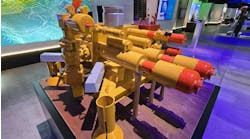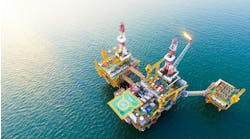Worldwide interest for Viking's offshore chute-based evacuation systems is increasing. The solution developed by the group at its offices in Bergen, Norway, has been taken up on installations throughout the North Sea. In the near future, the company will be testing new prototype versions for offshore use in Arctic and sub-tropical waters.
The first prototype for the offshore sector was tested in 1986 in the North Sea. Technical Manager Lars Bjoland has been following development of the system from day one: "Until our prototype was introduced, the offshore market only had access to much higher-risk systems such as davit-launched life rafts and lifeboats.
"The drop-release Viking chute, with its stabilizing weight, provided a solution to the increased need for safety. Due to the weighted-down bottom end, the chute does not need a fixed point of anchorage. The stability is not affected even by strong winds. On one occasion, with winds approaching hurricane force, the prototype hung out-stretched for a whole night.
"Our system is also efficient, with speedy evacuation of people in a zigzag pattern down through the chute and onto the system's boarding platform." The system is delivered in a steel walled container comprising winch, chute and life rafts.
Prototype installation on Statoil's Statpipe 16/11-S platform.
null
Bergen has now developed a new prototype solution that combines evacuation and entry. "This is made with a larger chute diameter than our other models," says Bjoland. "The result is maximum strength, while keeping the weight as low as possible. We have had a lot of interest from both existing and new markets." The latter include Brazil and the Gulf of Mexico. Here, Bjoland claims, operators are seeking alternative safer methods of safe entry and evacuation: workers are currently shuttled to and from their installations by boat, and hoisted from the boat to the platform with nets and ropes.
"There is also growing interest in Arctic offshore areas, but until recently, the severe conditions have put limitations on our activities. Viking is currently involved in an exciting project offshore eastern Russia, where fog and ice makes evacuation by helicopter unsafe, and the thick ice formation makes it impossible to use free-fall lifeboats on the platforms. We believe a modified chute system is the answer.
"For this particular project, standby boats with icebreaker capabilities are stationed near the platform. Should an emergency arise on the platform, the boats will move in and take the evacuees onboard. The challenge for us has been to develop a system that can handle different wave sizes. Our conventional chute has a stabilizing weight underneath the boarding platform - the weight is lowered into the sea, and the chute is thereby secured tight.
Installation of Selstair entry and access system on the Varg FPSO.
null
"This process will not work when the chute is lowered onto the deck of a ship, so we have developed an alternative whereby a passively compensating weight is integrated into the system's container onboard the platform. When lowered onto a ship's deck, the boarding platform is not activated, and expedient evacuation can get under way."
In warmer months, when evacuation in this project is performed using life rafts, the new Viking system will continue to function, Bjoland says. "The first prototype for Arctic areas was designed and developed by us in Norway, and to the best of our knowledge we are alone in offering a system that is stable in all kinds of climatic conditions."
Viking is delivering evacuation equipment to BP for the Holstein development in the Gulf of Mexico, and has sent identical equipment to the Consulting & Safety Specialists training center near New Orleans. "What makes this center special is that it is built as an indoor facility," Bjoland says. "To provide effective chute training for offshore staff, a 20 meter tall tower was constructed and placed in an enormous pool.
"Everything is indoors, with the emphasis on creating the highest possible levels of safety for the crews. The facilities opened in January, and all crews on the platform will undergo intensive training. Everyone will get a realistic first-hand experience of how the Viking chute evacuation system works in an emergency, how it is released from the container, and so on." Other safety training centers with Viking chutes at their facilities include Nutec in Bergen and RGIT in Dundee, Scotland.





